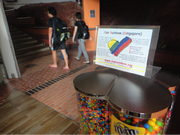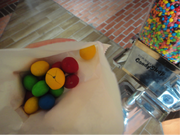By Nur Sulyanna Sumali
Colourful round candies shone brightly in their silver ‘Gourmet CandyShop’ dispenser. Countless people pass by it everyday, but few stop by. Are the dispensers collecting funds, or dust, over time?
Club Rainbow Singapore was established in 1992. Supporting more than 470 children, youths and their families till date, the registered charity helps those with diverse chronic diseases. Although it has been around for a long time, 19 years to be exact, Club Rainbow Singapore is not as widely recognized as – for example, the Children’s Society. This is perhaps due to the lack of publicity and less fruitful ways of collecting funds.
Case in Point: The candy dispensers. Located at various places around the country, they can be found at educational institutions like polytechnics and Public Services Board Academy (PSB Academy), Mass Rapid Transit (MRT) stations, and shopping malls, usually near eateries. Despite that, the fact is not many people are even aware of its existence. When asked about the candy dispensers, six out of ten people stated that they have not seen it before. For those who have, they rarely see any buyers. Some do not even know that it is for charity. Only a few have actually bought it themselves, but for a reason that is different from the intended purpose of the machines.
Miss Melody Lee 21, a Diploma in Creative Writing for TV and New Media (DTVM) student in Singapore Polytechnic (SP), bought the candies to “satisfy her sudden craving”, not to contribute to society. However, she was displeased to find that the small paper bags to hold the candies are missing. As such, she had to hold them in her hand, which she then realised that the candies fill less than a ‘handful’.
The same goes for Miss Elly Saad 19, a fellow classmate of the abovementioned Miss Lee. For $1, she received only eight pieces of the peanut M&Ms. The average cost of M&Ms in Singapore is about $1.60, and one can get three times the amount of candies.
What’s more, there was nothing about the candy dispensers on the organisation’s website (http://www.clubrainbow.org/). Efforts made to contact the organisers are in vain. It seems that the silver dispensers are really just a white elephant, like the Rainbow Care and Resource Centre at the National University Hospital (NUH).
Apparently, “The number of people that use the facilities is less than ten per day”, according to Mr Sumali Marsis 52, a Medical Records Officer at NUH.
Perhaps promoting Club Rainbow through Flag Day would be likely to receive donations a lot more in one day, then the amount collected through the candy dispensers in a week. Lets hope that the charity would have better strategies in the future, in order to stay committed in helping those in need.

Club Rainbow’s candy dispenser at a café in Singapore Polytechnic, still filled to the brim, is perhaps targeting the wrong consumers.

Just because it is ‘for charity’ does not mean that it is worth buying.